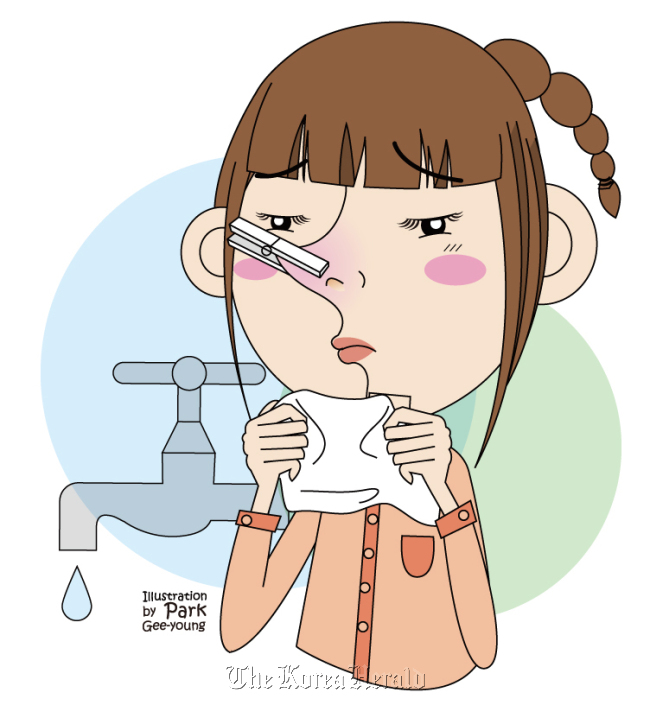The nose has an important cosmetic function and also serves an even more important physiological role especially in respiration. Any problems with the respiratory function of the nose will lead to symptoms of nasal obstruction. People with normal respiratory function are not conscious of their breathing but patients with nasal obstruction as well as those around them experience stuffiness as a result.
There are several conditions which cause nasal obstruction, the most common of which is rhinitis. The exact prevalence of rhinitis in Korea is not known, but it is known to be very common in the U.S. where approximately 4 million (1/7 of the population) suffer from it.

Rhinitis, as its name suggests, is an inflammation of the nose. To be exact, it refers to the inflammatory pathology of the mucous membranes lining the surface of the nasal cavity. In rhinitis, the mucous membrane is swollen, causing a decrease in the area of the nasal cavity, which leads to increased nasal discharge and nasal obstruction.
Other common causes of nasal obstruction include anatomical changes causing chronic hypertrophic rhinitis and nasal septum deviation (where the middle bone of the nose is bent). Other common clinical conditions causing nasal obstruction includes rhinitis with similar symptoms to allergic rhinitis without a known antigen; vasomotor rhinitis, which is caused by an imbalanced autonomic nervous system; and chronic sinusitis (empyema).
Nasal obstruction can cause problems especially for students as it can lead to decreased concentration and thus a decreased academic performance. This is because it is commonly caused by allergic rhinitis or empyema, making students need to blow their noses frequently and decreasing their concentration levels.
Severe nasal obstruction should be seen by a doctor for accurate diagnosis and proper treatment in order to address the cause, but the easiest method to relieve the symptoms is to use nasal sprays, which act locally to constrict the mucous membrane lining. However, nasal sprays should be used with caution, as chronic use of such nasal sprays can cause dysfunction of the normal aperiodism (the nostrils usually take regular turns to act as the main respiratory nostril while the other one is resting), which can in turn lead to pharmacological rhinitis.
Outpatients frequently complain that they have alternating obstruction of the left and right nostrils or complain of worsening nasal obstruction during the night and that when they lie on their side, the nostril on that side becomes blocked. This is a normal physiological response due to the aperiodism and changes in posture. However, if it is present with the symptoms listed above, it can make the feelings of nasal obstruction worse so it is recommended that such patients seek medical advice.
There are several conditions which cause nasal obstruction, the most common of which is rhinitis. The exact prevalence of rhinitis in Korea is not known, but it is known to be very common in the U.S. where approximately 4 million (1/7 of the population) suffer from it.

Rhinitis, as its name suggests, is an inflammation of the nose. To be exact, it refers to the inflammatory pathology of the mucous membranes lining the surface of the nasal cavity. In rhinitis, the mucous membrane is swollen, causing a decrease in the area of the nasal cavity, which leads to increased nasal discharge and nasal obstruction.
Other common causes of nasal obstruction include anatomical changes causing chronic hypertrophic rhinitis and nasal septum deviation (where the middle bone of the nose is bent). Other common clinical conditions causing nasal obstruction includes rhinitis with similar symptoms to allergic rhinitis without a known antigen; vasomotor rhinitis, which is caused by an imbalanced autonomic nervous system; and chronic sinusitis (empyema).
Nasal obstruction can cause problems especially for students as it can lead to decreased concentration and thus a decreased academic performance. This is because it is commonly caused by allergic rhinitis or empyema, making students need to blow their noses frequently and decreasing their concentration levels.
Severe nasal obstruction should be seen by a doctor for accurate diagnosis and proper treatment in order to address the cause, but the easiest method to relieve the symptoms is to use nasal sprays, which act locally to constrict the mucous membrane lining. However, nasal sprays should be used with caution, as chronic use of such nasal sprays can cause dysfunction of the normal aperiodism (the nostrils usually take regular turns to act as the main respiratory nostril while the other one is resting), which can in turn lead to pharmacological rhinitis.
Outpatients frequently complain that they have alternating obstruction of the left and right nostrils or complain of worsening nasal obstruction during the night and that when they lie on their side, the nostril on that side becomes blocked. This is a normal physiological response due to the aperiodism and changes in posture. However, if it is present with the symptoms listed above, it can make the feelings of nasal obstruction worse so it is recommended that such patients seek medical advice.

By Dhong Hun -jong
The author is a doctor at Department of Otorhinolaryngology of Samsung Medical Center and professor at SungkyunKwan University School of Medicine.
-
Articles by Korea Herald



![[Herald Interview] 'Amid aging population, Korea to invite more young professionals from overseas'](http://res.heraldm.com/phpwas/restmb_idxmake.php?idx=644&simg=/content/image/2024/04/24/20240424050844_0.jpg&u=20240424200058)













![[KH Explains] Korean shipbuilding stocks rally: Real growth or bubble?](http://res.heraldm.com/phpwas/restmb_idxmake.php?idx=652&simg=/content/image/2024/04/25/20240425050656_0.jpg&u=)

